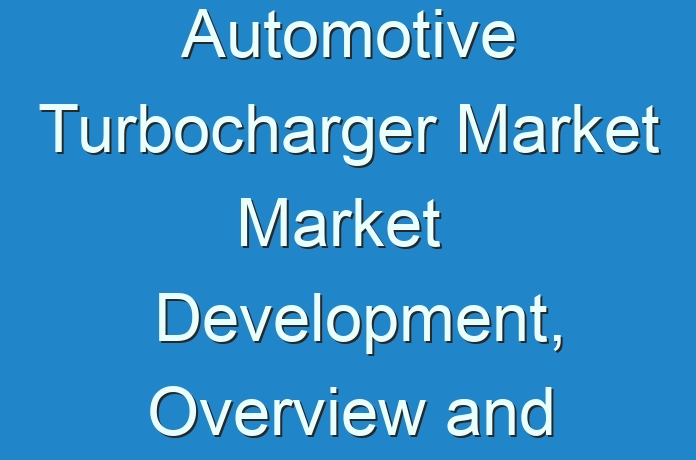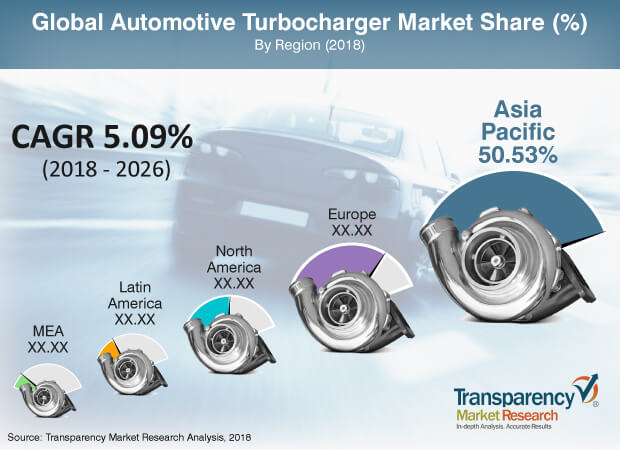
Automotive Turbocharger Market – Snapshot
The automotive turbocharger market is expected to surpass the value of US$ 34 Bn by 2026, expanding at a CAGR of more than 5% during the forecast period. The market is expected to expand significantly during the forecast period owing to the rising penetration of automotive turbochargers in vehicles.
The automotive turbocharger market is primarily driven by stringent emission norms across the globe. Rise in demand for vehicles with higher power output, coupled with stringent emission limits, has prompted manufacturers to install automotive turbochargers in their vehicles. Lower excise duty on smaller engines has compelled manufacturers to move toward engine downsizing, which can be achieved with the installation of turbochargers. On the other hand, adoption of turbocharger enables a smaller engine to deliver high power along with lower emission and higher fuel-economy, which is considered to be a key driver of the automotive turbocharger market. Engine downsizing also reduces the sprung mass on the vehicle, which enhances the fuel economy and performance of the vehicle.
Purchase our Premium Research Report At:https://www.transparencymarketresearch.com/checkout.php?rep_id=17264<ype=S

Automotive turbochargers are commonly utilized in diesel vehicles; however, the penetration of automotive turbochargers has risen significantly in gasoline vehicles in the last few years. Furthermore, the market for diesel vehicles is contracting due to higher exhaust emissions from diesel engines, as compared to that from gasoline engines. Therefore, the gasoline engine segment of the automotive turbocharger is anticipated to be more lucrative than the diesel engine segment during the forecast period. Production of diesel vehicles is anticipated to decline due to an expected ban on diesel vehicles in a few major cities that are experiencing high air pollution due to vehicle emissions, such as New Delhi, Frankfurt, Madrid, and Athens. Some regions such as North America, Latin America, and a few sub-regions of Asia Pacific have higher number of gasoline vehicles, which has contributed to the gasoline engine segment to hold a major share of the market. The gasoline engine segment is likely to expand at a significant pace during the forecast period.
Rising investments and expansion of research and development centers for development of automotive turbochargers have led to the development of e-turbochargers, which are considered as the future of turbochargers for the automotive industry. The e-turbocharger was developed to overcome turbo lag that is experienced in conventional turbochargers by eliminating the dependency of compressor on exhaust of the engine. Penetration of e-turbochargers has been rising at a significant pace in the last few years. Previously, e-turbochargers were only utilized in premium vehicles; however, they are presently being employed in medium segment vehicles. Their penetration is expected to rise significantly during the forecast period due to several advantages they possess over conventional turbochargers, such as elimination of turbo-lag, lower heating of the engine chamber due to lower rpm of the turbine, improved engine efficiency, and comprises fewer components, which reduce the weight of the vehicle.
Get More Press Releases by TMR: https://www.prnewswire.com/news-releases/government-policies-encouraging-use-of-electric-vehicles-to-reduce-environmental-pollution-to-boost-electric-vehicle-charging-station-market-innovations-in-automotive-technology-to-intensify-competition—tmr-301317344.html
The market for automotive turbochargers is anticipated to expand at a notable pace in regions with significantly higher penetration of gasoline engines, such as Latin America, owing to the increase in penetration of turbochargers in gasoline engines coupled with significant market share held by the gasoline engine segment in the global automotive turbocharger market.
In terms of technology, the VGT/ VNT (Variable geometry turbochargers or variable nozzle turbochargers) segment is expected to hold a considerable share of the market due to its low boost threshold and efficiency at higher speeds. VGT/VNT turbochargers have been primarily developed for diesel engines owing to their higher capability to vary the effective aspect ratio of the engine from higher engine speed to lower engine speed, thus it enhanced the efficiency of diesel engines effectively and is currently penetrating gasoline vehicles owing to its higher efficiency over fixed geometry turbochargers. However, development in technology and better response and efficiency have enabled their adoption in gasoline engines and hence, the segment is expected to expand at a steady pace during the forecast period. Significant rise in the production and sales of luxury vehicles has boosted the twin turbo technology segment. Moreover, further rise in sales of luxury vehicles is expected to propel the twin turbo technology segment in the near future. Twin turbo technology is mostly utilized in V-engines, and it also multiplies the effect of turbocharging, which significantly boosts the performance of the vehicle. Furthermore, sales of luxury vehicles are expected to rise due to increase in purchasing power parity of society, primarily in developed countries such as the U.S., Canada, Germany, and Australia.
To gauge the scope of customization in our reports, Ask for a Sample
Major players operating in the global automotive turbocharger market include Honeywell International Inc., IHI Corporation, MAHLE GmbH, Robert Bosch GmbH, BorgWarner Inc., Delphi Technologies, Cummins Inc., Eaton, Continental AG, Mitsubishi Heavy Industries Ltd., and Cardone Industries. Honeywell International Inc. is a leading manufacturer of automotive turbochargers in the global market and has been primarily focusing on product differentiation, manufacturing footprint optimization, and operational excellence in order to consolidate its position in the market. The company primarily focuses on emerging markets for turbochargers and competes in the market by structural cost leadership.
Vehicle Emission Norms Key Force Behind Shaping Automotive Turbocharger Market
Automotive turbochargers affect the vehicle along a range of parameters, most notably fuel economy, engine performance, and power delivered to automotive. Their main aim is to drive the charge air pressures in internal combustion engines. Over the years, turbochargers have become commonplace. They have gained preference over naturally aspirated engines. The turbochargers market is driven by advancements in design and also the use of materials. Most importantly, changes in vehicle emission norms in various countries are key factors that set the tone for product advancements. Advances in bearing systems have enabled automakers to incorporate turbochargers with high performance, thus expanding the demand potential in the turbochargers market. A range of seals have been developed that are compatible with different new array of turbochargers. The growing popularity of turbocharged sports cars has fuelled the prospects in the turbochargers market. New types of turbocharger constructions have come to the fore for meeting the needs of original equipment manufacturers in the automotive and automobile market. The increasing trend of engine downsizing is expected to play crucial role in shaping the dynamics of product innovations, thereby influencing the contours of competition in the market.
The Covid-19 pandemic has led to vast upheaval to the healthcare systems across the globe. Not just humanitarian crises, the outbreaks triggered substantial changes in regulations pertaining to the production and manufacturing in various industries, and increasingly the services sectors. The automotive and automobile industry witnessed some of the ugly impacts due to decline in the new demand. On the other hand, the electrification of transportation industry is a new trend that will spur growth momentum in the automotive turbochargers market, as incumbent players might look for unlocking new consumer propositions. However, the uncertainty in consumer demands still continues due to the high mortality and morbidity of the infectious disease. The consistent focus of governments on getting a large portion of population vaccinated might help propel the market sentiments, opine experts.
Booming Automobile Sales to Underscore Growth in Automotive Turbocharger Market
The automotive turbocharger market is expected to gain extensively during the forecast period of 2018-2026 on the back of the rising adoption in commercial, passenger, and heavy-duty vehicles. Fuel efficiency has become an important factor for increasing the revenues of the players in the automobile industry. Thus, this factor has a positive impact on the growth of the automotive turbocharger market.
- A turbocharger is an induction device that’s turbine-driven which helps in escalating the efficiency and energy output by sending the extra compressed air into the combustion chamber. The overwhelming benefits attached to automotive turbochargers will bring profitable growth opportunities for the automotive turbocharger market.
- The sales of passenger vehicles have increased exponentially due to the rising disposable income, escalating urbanization levels, and an increase in the purchasing power parity of individuals across the globe. The rising sales of passenger vehicles are directly proportional to the growth of the automotive turbocharger market.
- Manufacturers in the automotive turbocharger market are involved in research and development activities. The players in the automotive turbocharger market invest heftily in these activities for boosting their revenues. Strategic collaborations also play a significant role in the growth of the automotive turbocharger market. The collaborations also help in strengthening the foothold of the players in the automotive turbocharger market.
- The COVID-19 pandemic has disrupted the growth projections of many industries and sectors across the globe. The automotive turbocharger market is no exception. The automotive turbocharger market has been affected gravely due to the novel coronavirus outbreak. The imposition of strict lockdown restrictions in many countries led to the closure of manufacturing facilities and production units. These factors led to a decline in the production and demand of automotive turbochargers.
- Nevertheless, many countries started announcing relaxations in lockdown restrictions for bringing the trailing economy on track. These restrictions allowed the industries to operate with all the necessary SOPs in place, thus providing relief to the players in the automotive turbocharger market.
Contact us:
Transparency Market Research
State Tower,
90 State Street, Suite 700,
Albany NY – 12207,
United States
Tel: +1-518-618-1030 Email: sales@transparencymarketresearch.com
Website: https://www.transparencymarketresearch.com
https://todaysmarkettrends.wordpress.com





